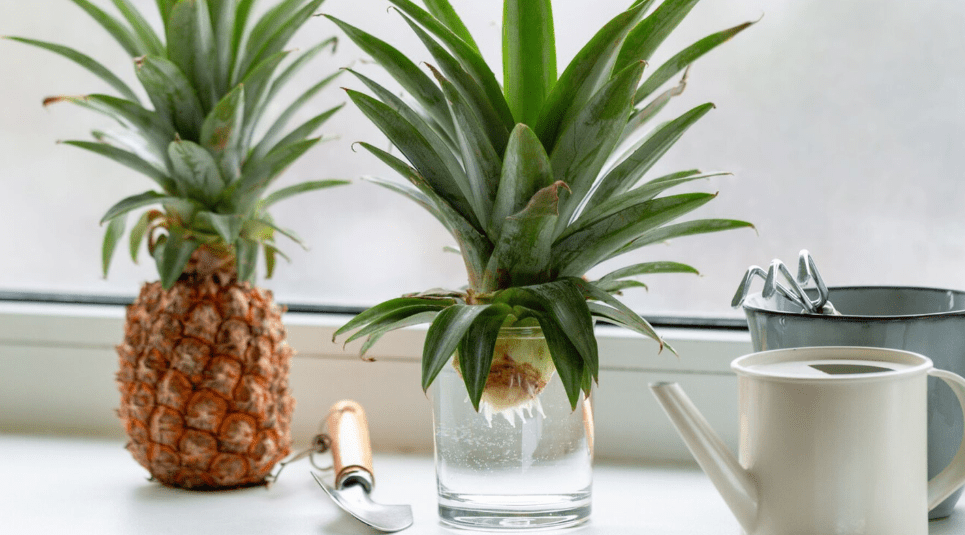
Pineapple Plant with Pineapple: Growing Tips and Tricks
Growing a pineapple plant with pineapple is a rewarding and enjoyable experience that adds a tropical touch to your home garden. Not only do pineapple plants make attractive houseplants, but they also provide the satisfaction of producing your own sweet, juicy pineapples. In this guide, we’ll cover everything you need to know about successfully growing a pineapple plant with pineapple, from choosing the right pineapple to planting, caring for, and harvesting your fruit.
Table of Contents
ToggleUnderstanding the Pineapple Plant
A. Botanical Overview
The pineapple plant, also known as Ananas comosus, is a tropical plant that belongs to the bromeliad family. It is native to South America and is known for its spiky green leaves and large, sweet fruit. Pineapple plants can be grown indoors or outdoors, depending on your climate, and they thrive in warm, humid conditions.
1.Origin and natural habitat
Pineapple plants are native to South America and are typically found in tropical regions with warm, humid climates. They are often grown in countries such as Brazil, the Philippines, and Thailand, where the conditions are ideal for pineapple production.
2.Growth habits
Pineapple plants have a rosette shape with long, spiky leaves that can reach up to 5 feet in length. The plant’s fruit, which is actually a cluster of berries that fuse together, grows from the center of the rosette on a thick, sturdy stem.
B. Varieties of Pineapple Plants
1. Common varieties (Smooth Cayenne, Red Spanish, Queen, etc.)
There are several common varieties of pineapple plants, including Smooth Cayenne, Red Spanish, and Queen. Smooth Cayenne is the most widely grown variety and is known for its sweet, juicy fruit and low acidity. Red Spanish pineapples have a slightly more tangy flavor and are often used for canning. The Queen variety produces smaller, more compact fruit and is favored for its intense sweetness. Each variety has its own unique flavor profile and growing requirements, so be sure to choose the one that best suits your preferences and growing conditions. No matter which variety you choose, growing a pineapple plant can be a rewarding and fun experience. With the right care and attention, you can enjoy delicious, home-grown pineapples right in your own backyard.
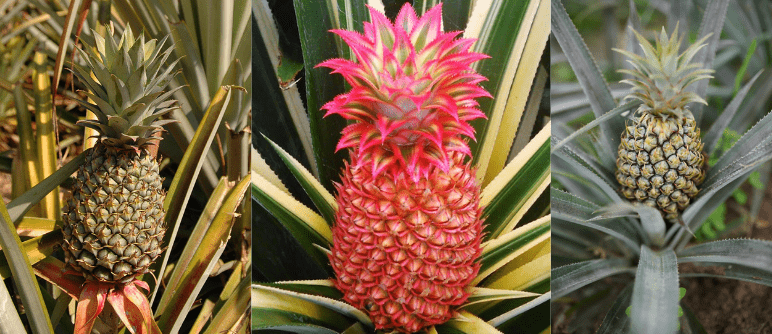
Getting Started with Pineapple Plants
A. Choosing the Right Pineapple Variety
When it comes to choosing the right pineapple variety to grow, there are a few options to consider. The Smooth Cayenne variety is known for its sweet, juicy fruit and low acidity, making it a popular choice among growers. The Red Spanish pineapple has a slightly more tangy flavor and is often used for canning. The Queen variety produces smaller, more compact fruit and is favored for its intense sweetness. Each variety has its own unique flavor profile and growing requirements, so it’s important to consider your preferences and growing conditions before making a decision.
No matter which variety you choose, growing a pineapple plant can be a rewarding and fun experience. With the right care and attention, you can enjoy delicious, home-grown pineapples right in your own backyard. Consider researching the specific growing requirements for each variety to ensure the best results.
B. Preparing the Pineapple Top
1. Steps to prepare the pineapple crown for planting
To prepare a pineapple crown for planting, first, select a fresh pineapple with healthy, green leaves. Twist or cut off the crown, making sure to remove any excess fruit flesh. Next, remove some of the lower leaves to expose the stem. Allow the crown to dry for a few days to prevent rotting. Once dry, plant the crown in well-draining soil, making sure the stem is securely planted and the leaves are above the soil line. Water the plant and place it in a sunny location, and soon you’ll be on your way to growing your own pineapple.
C. Planting the Pineapple Top
1. Soil preparation and pot selection
To prepare the soil for planting your pineapple top, you’ll want to choose well-draining soil and a pot with adequate drainage holes. This will help prevent water from pooling and causing root rot. It’s important to ensure the stem of the pineapple top is securely planted in the soil, with the leaves above the soil line. This will help the plant establish itself and begin growing successfully.
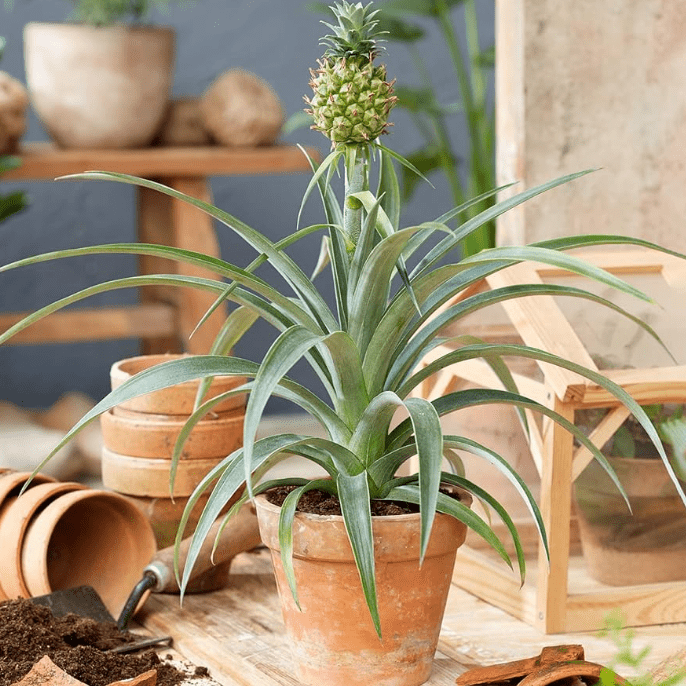
2. Proper planting depth and spacing
When planting the pineapple top, you’ll want to ensure it is planted at the proper depth, with the stem securely in the soil and the leaves above the soil line. It’s also important to space the pineapple tops apart to allow for proper growth and development. This will ensure that each plant has enough space to thrive and produce healthy fruit.
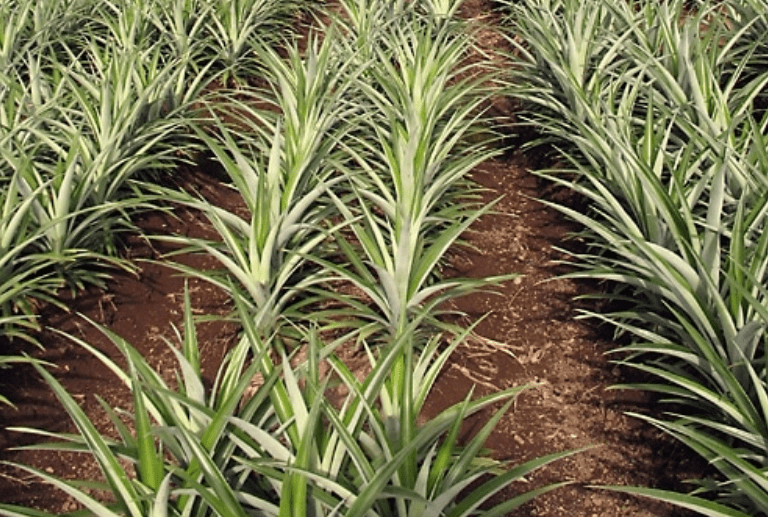
Growing Conditions and Care
A. Ideal Growing Conditions
To ensure successful growth, it’s important to provide the pineapple plant with ideal growing conditions. This includes full sun exposure, well-draining soil, and regular watering. Pineapples thrive in warm, tropical climates and can also be grown in containers indoors. It’s important to monitor the soil moisture and avoid overwatering to prevent root rot. Additionally, fertilizing the plant with a balanced fertilizer can help promote healthy growth and fruit production. With proper care and attention to growing conditions, your pineapple plant will thrive and produce delicious fruit.
B. Watering and Fertilizing
When it comes to watering and fertilizing your pineapple plant, it’s important to find the right balance. Pineapples require regular watering, but it’s important to avoid overwatering to prevent root rot. Checking the soil moisture and only watering when the top inch of soil is dry is a good rule of thumb. Additionally, using a well-balanced fertilizer can help promote healthy growth and fruit production. It’s best to fertilize the plant every 6-8 weeks during the growing season. By providing the right amount of water and nutrients, you can ensure your pineapple plant thrives and produces tasty fruit.
C. Pruning and Maintenance
When it comes to pruning and maintaining your pineapple plant, there are a few key things to keep in mind. Pruning can help promote healthy growth and fruit production by removing any dead or damaged leaves. It’s important to be careful when handling the plant, as the leaves can be sharp and prickly.
In terms of maintenance, it’s important to keep an eye out for any pests or diseases that may affect the plant. Regularly inspecting the leaves and fruit for any signs of damage or discoloration can help catch any issues early on.
Additionally, providing support for the fruit as it grows can help prevent the plant from becoming top-heavy and tipping over. Using a stake or support system can help keep the plant stable as the fruit develops.
By staying on top of pruning and maintenance, you can help ensure that your pineapple plant remains healthy and productive.
Encouraging Fruit Production
A. Timing and Patience
It’s important to be patient when it comes to fruit production with pineapple plants. It can take up to two years for a pineapple plant to produce fruit, so it’s important to be patient and not expect immediate results. Additionally, it’s important to ensure that the plant is receiving the right amount of sunlight, water, and nutrients to encourage fruit production. Maintaining consistent care and providing the necessary support for the plant as it grows can also help encourage fruit production. Overall, it’s important to have realistic expectations and to give the plant time to develop and produce fruit.
B. Inducing Flowering
To induce flowering in your pineapple plant, it’s important to ensure that it is receiving the right environmental conditions. This includes providing adequate sunlight, maintaining the proper soil pH, and ensuring that the plant is well-watered and fertilized. Additionally, you can encourage flowering by exposing the plant to cooler temperatures for a short period of time, which can help stimulate the production of flower buds. It’s also important to keep up with regular pruning and maintenance to ensure that the plant is healthy and has the energy to produce flowers and fruit. By taking these steps, you can help ensure that your pineapple plant is more likely to produce fruit.
C. Pollination and Fruit Development
Once your pineapple plant has successfully flowered, it’s important to understand the process of pollination and fruit development. Pineapple plants are typically self-pollinating, meaning that they can pollinate themselves without the need for another plant. However, if you notice that your plant is not producing fruit, you can help facilitate pollination by gently shaking the plant to distribute the pollen.
After successful pollination, it’s important to keep the plant well-watered and continue to provide the proper environmental conditions to support fruit development. This includes maintaining consistent moisture levels and providing the plant with the necessary nutrients. It’s also important to be patient, as it can take several months for the pineapple fruit to fully develop and ripen. By understanding the process of pollination and fruit development and providing the right care, you can increase the likelihood of your pineapple plant producing tasty fruit.
Harvesting and Beyond
A. When to Harvest
Pineapples are typically ready to harvest when they have reached their full size and have developed a golden yellow color. You can also gently tug on the fruit to see if it easily releases from the plant, which indicates that it is ready to be harvested. Once harvested, it’s important to store the pineapple at room temperature until it reaches its peak ripeness. You can then enjoy your homegrown pineapple or use it in various recipes.
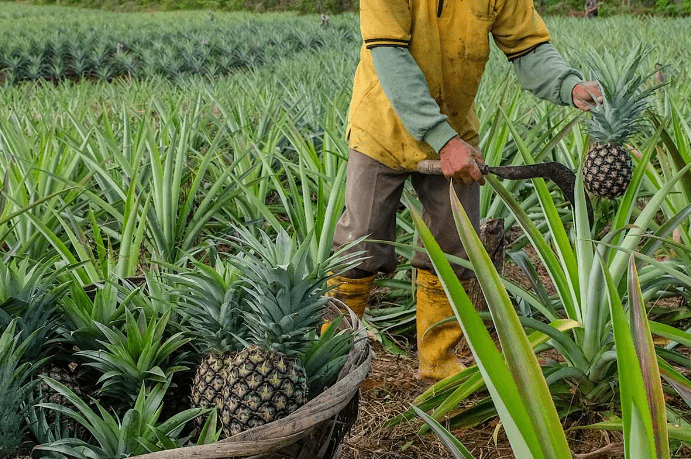
B. Post-Harvest Care
After harvesting your pineapple, it’s important to continue providing proper care to ensure its longevity and quality. Place the pineapple in a cool, dry area away from direct sunlight, and avoid storing it in the refrigerator as it can negatively affect the flavor and texture. If you plan on consuming the pineapple within a few days, you can store it at room temperature. However, if you want to prolong its shelf life, you can store it in the refrigerator for up to a week. Just be sure to bring it back to room temperature before consuming for the best flavor. With the right care, you can enjoy the fruits of your labor for as long as possible.
C. Propagating New Plants
To propagate new pineapple plants, you can use the pineapple top or crown. Simply twist off the crown from the top of the fruit, making sure to remove any excess fruit flesh. Once cleaned, you can let the crown air dry for a few days to allow the cut to callus over. Afterward, you can plant the crown in well-draining soil, making sure to water it regularly and provide it with plenty of sunlight. With proper care, the crown should start to grow roots and eventually produce a new pineapple plant. This method allows you to continue growing fresh pineapples from the comfort of your own home.
Common Problems and Solutions
A. Dealing with Pests and Diseases
When propagating new plants, it is important to be aware of common pests and diseases that may affect your plants. Some common pests that may affect pineapple plants include aphids, mealybugs, and scale insects. To prevent these pests, you can regularly inspect your plants for any signs of infestation and use natural pest control methods, such as neem oil or insecticidal soap, to treat any issues.
In terms of diseases, pineapple plants can be affected by fusarium wilt, root rot, and pineapple disease. To prevent these diseases, it’s important to plant your pineapple crown in well-draining soil and avoid overwatering. If you notice any signs of disease, such as wilting leaves or discoloration, it’s important to address the issue promptly and consider using fungicides or other treatments as needed.
Overall, being proactive in monitoring your plants and taking preventive measures can help keep your new pineapple plants healthy and thriving.
B. Troubleshooting Growth Issues
When dealing with growth issues in pineapple plants, it’s important to consider potential factors that may be affecting their development. Common growth issues can include stunted growth, yellowing leaves, or poor fruit production. To troubleshoot these issues, it’s important to ensure that your pineapple plants are receiving adequate sunlight, water, and nutrients. Additionally, it’s essential to monitor the soil pH and make adjustments as needed to maintain optimal growing conditions. If you notice any signs of pests or diseases, it’s important to address these issues promptly using appropriate treatments. Overall, maintaining a healthy growing environment and addressing any potential issues promptly can help promote healthy growth in your pineapple plants.
Benefits of Growing Pineapples
A. Nutritional and Culinary Benefits
Growing pineapples can provide both nutritional and culinary benefits. Pineapples are rich in vitamins, particularly vitamin C, and minerals such as manganese and copper. They also contain bromelain, an enzyme that may have anti-inflammatory and digestive benefits. In terms of culinary benefits, homegrown pineapples offer a fresh and flavorful addition to meals and snacks. They can be enjoyed on their own, added to fruit salads, used in smoothies, or incorporated into various recipes for a tropical twist. Additionally, growing pineapples at home can provide a sense of satisfaction and connection to the food you consume. Overall, the nutritional and culinary benefits of growing pineapples can be quite rewarding.
B. Aesthetic and Decorative Uses
Pineapples can also be used for aesthetic and decorative purposes. Their unique shape and vibrant, tropical appearance make them a popular choice for adding a touch of color and flair to home decor. Whether used as a centerpiece, incorporated into floral arrangements, or simply displayed on their own, pineapples can add a stylish and cheerful element to any room. Additionally, pineapple motifs are often used in fashion and design, further adding to their aesthetic appeal. Overall, the aesthetic and decorative uses of pineapples can add a fun and lively vibe to your surroundings.
In conclusion, growing a pineapple plant with an actual pineapple fruit can be a fun and rewarding experience. It’s important to choose a ripe pineapple with healthy leaves and follow the proper planting and care instructions to ensure success. With the right tips and tricks, you can enjoy the satisfaction of growing your own pineapple plant and eventually harvesting a delicious pineapple fruit.
Frequently Asked Questions (FAQs)
Yes, you can! Simply cut off the leafy top of a pineapple, let it dry for a few days, and then plant it in well-draining soil.
It can take anywhere from 18 months to 3 years for a pineapple plant to produce fruit, so patience is key.
Pineapple plants thrive in well-draining, sandy soil with a slightly acidic pH level.
Pineapple plants prefer regular watering, but they are also drought-tolerant. It’s important not to overwater them, as they are susceptible to root rot.
Yes, pineapple plants can be grown indoors in a sunny location, but they do require plenty of sunlight to thrive.
A mature pineapple plant can reach up to 5 feet in height and width, so it’s important to give it plenty of space to grow.
A ripe pineapple will have a sweet aroma at the base, and the outer skin will turn golden yellow. You can also gently tug on the leaves – if they come out easily, the pineapple is ready to be harvested.
Pineapple plants thrive in warm, tropical climates, but they can also be grown in containers indoors or in a greenhouse in cooler climates. Just make sure to provide them with plenty of warmth and sunlight.
